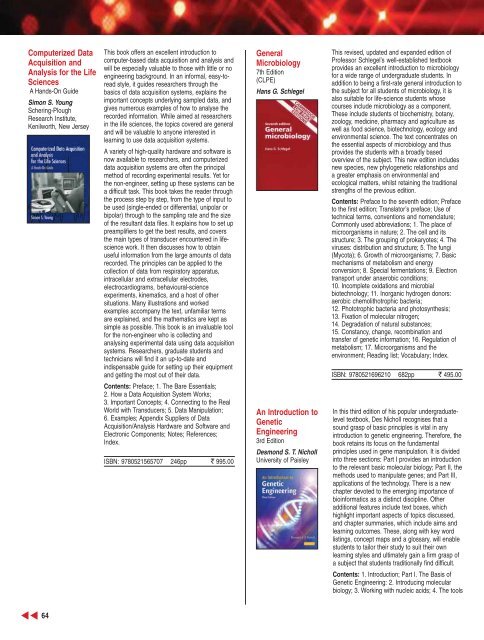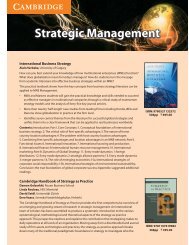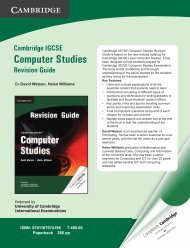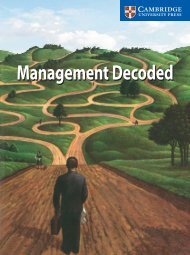ENGINEERING - Cambridge University Press India
ENGINEERING - Cambridge University Press India
ENGINEERING - Cambridge University Press India
You also want an ePaper? Increase the reach of your titles
YUMPU automatically turns print PDFs into web optimized ePapers that Google loves.
Computerized Data<br />
Acquisition and<br />
Analysis for the Life<br />
Sciences<br />
A Hands-On Guide<br />
Simon S. Young<br />
Schering-Plough<br />
Research Institute,<br />
Kenilworth, New Jersey<br />
This book offers an excellent introduction to<br />
computer-based data acquisition and analysis and<br />
will be especially valuable to those with little or no<br />
engineering background. In an informal, easy-toread<br />
style, it guides researchers through the<br />
basics of data acquisition systems, explains the<br />
important concepts underlying sampled data, and<br />
gives numerous examples of how to analyse the<br />
recorded information. While aimed at researchers<br />
in the life sciences, the topics covered are general<br />
and will be valuable to anyone interested in<br />
learning to use data acquisition systems.<br />
A variety of high-quality hardware and software is<br />
now available to researchers, and computerized<br />
data acquisition systems are often the principal<br />
method of recording experimental results. Yet for<br />
the non-engineer, setting up these systems can be<br />
a difficult task. This book takes the reader through<br />
the process step by step, from the type of input to<br />
be used (single-ended or differential, unipolar or<br />
bipolar) through to the sampling rate and the size<br />
of the resultant data files. It explains how to set up<br />
preamplifiers to get the best results, and covers<br />
the main types of transducer encountered in lifescience<br />
work. It then discusses how to obtain<br />
useful information from the large amounts of data<br />
recorded. The principles can be applied to the<br />
collection of data from respiratory apparatus,<br />
intracellular and extracellular electrodes,<br />
electrocardiograms, behavioural-science<br />
experiments, kinematics, and a host of other<br />
situations. Many illustrations and worked<br />
examples accompany the text, unfamiliar terms<br />
are explained, and the mathematics are kept as<br />
simple as possible. This book is an invaluable tool<br />
for the non-engineer who is collecting and<br />
analysing experimental data using data acquisition<br />
systems. Researchers, graduate students and<br />
technicians will find it an up-to-date and<br />
indispensable guide for setting up their equipment<br />
and getting the most out of their data.<br />
Contents: Preface; 1. The Bare Essentials;<br />
2. How a Data Acquisition System Works;<br />
3. Important Concepts; 4. Connecting to the Real<br />
World with Transducers; 5. Data Manipulation;<br />
6. Examples; Appendix Suppliers of Data<br />
Acquisition/Analysis Hardware and Software and<br />
Electronic Components; Notes; References;<br />
Index.<br />
ISBN: 9780521565707 246pp ` 995.00<br />
General<br />
Microbiology<br />
7th Edition<br />
(CLPE)<br />
Hans G. Schlegel<br />
An Introduction to<br />
Genetic<br />
Engineering<br />
3rd Edition<br />
Desmond S. T. Nicholl<br />
<strong>University</strong> of Paisley<br />
This revised, updated and expanded edition of<br />
Professor Schlegel’s well-established textbook<br />
provides an excellent introduction to microbiology<br />
for a wide range of undergraduate students. In<br />
addition to being a first-rate general introduction to<br />
the subject for all students of microbiology, it is<br />
also suitable for life-science students whose<br />
courses include microbiology as a component.<br />
These include students of biochemistry, botany,<br />
zoology, medicine, pharmacy and agriculture as<br />
well as food science, biotechnology, ecology and<br />
environmental science. The text concentrates on<br />
the essential aspects of microbiology and thus<br />
provides the students with a broadly based<br />
overview of the subject. This new edition includes<br />
new species, new phylogenetic relationships and<br />
a greater emphasis on environmental and<br />
ecological matters, whilst retaining the traditional<br />
strengths of the previous edition.<br />
Contents: Preface to the seventh edition; Preface<br />
to the first edition; Translator’s preface; Use of<br />
technical terms, conventions and nomenclature;<br />
Commonly used abbreviations; 1. The place of<br />
microorganisms in nature; 2. The cell and its<br />
structure; 3. The grouping of prokaryotes; 4. The<br />
viruses: distribution and structure; 5. The fungi<br />
(Mycota); 6. Growth of microorganisms; 7. Basic<br />
mechanisms of metabolism and energy<br />
conversion; 8. Special fermentations; 9. Electron<br />
transport under anaerobic conditions;<br />
10. Incomplete oxidations and microbial<br />
biotechnology; 11. Inorganic hydrogen donors:<br />
aerobic chemolithotrophic bacteria;<br />
12. Phototrophic bacteria and photosynthesis;<br />
13. Fixation of molecular nitrogen;<br />
14. Degradation of natural substances;<br />
15. Constancy, change, recombination and<br />
transfer of genetic information; 16. Regulation of<br />
metabolism; 17. Microorganisms and the<br />
environment; Reading list; Vocabulary; Index.<br />
ISBN: 9780521696210 682pp ` 495.00<br />
In this third edition of his popular undergraduatelevel<br />
textbook, Des Nicholl recognises that a<br />
sound grasp of basic principles is vital in any<br />
introduction to genetic engineering. Therefore, the<br />
book retains its focus on the fundamental<br />
principles used in gene manipulation. It is divided<br />
into three sections: Part I provides an introduction<br />
to the relevant basic molecular biology; Part II, the<br />
methods used to manipulate genes; and Part III,<br />
applications of the technology. There is a new<br />
chapter devoted to the emerging importance of<br />
bioinformatics as a distinct discipline. Other<br />
additional features include text boxes, which<br />
highlight important aspects of topics discussed,<br />
and chapter summaries, which include aims and<br />
learning outcomes. These, along with key word<br />
listings, concept maps and a glossary, will enable<br />
students to tailor their study to suit their own<br />
learning styles and ultimately gain a firm grasp of<br />
a subject that students traditionally find difficult.<br />
Contents: 1. Introduction; Part I. The Basis of<br />
Genetic Engineering: 2. Introducing molecular<br />
biology; 3. Working with nucleic acids; 4. The tools<br />
64

















